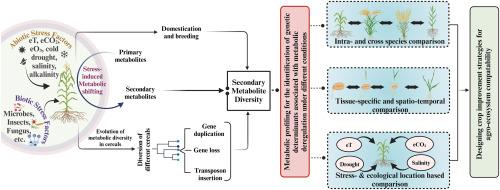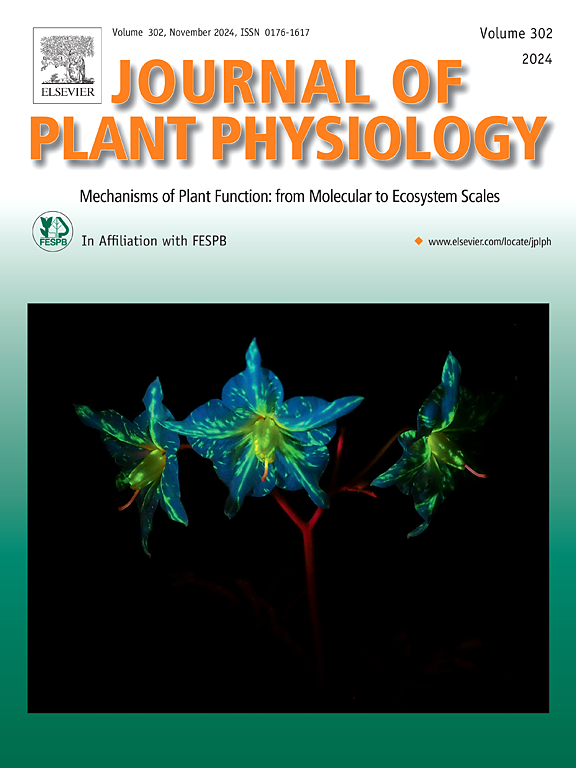探索遗传学和基因组学趋势,了解胁迫下谷物次生代谢基因与农艺性状之间的联系。
IF 4
3区 生物学
Q1 PLANT SCIENCES
引用次数: 0
摘要
植物代谢组被认为是基因组与其表型组之间的重要界面,在调节植物生长以应对各种环境线索方面发挥着重要作用。植物会产生大量的特化代谢物,这些代谢物对于介导环境相互作用和植物适应环境至关重要。值得注意的是,这些特化代谢物,特别是植物次生代谢物(PSMs)积累的增强是化学防御反应的一部分,与抗逆性的提高直接相关。因此,探索次生代谢物库巨大变异背后的遗传多样性可以揭示植物对不同环境胁迫的适应机制。后基因组分析平台使人们能够探索代谢多样性与重要农艺性状之间的联系。本综述侧重于利用先进的全局分析方法开展禾本科作物植物次生代谢物(PSM)研究的主要成就和未来挑战。有鉴于此,我们简要总结了为探索谷类作物中 PSMs 的遗传多样性和进化所采取的不同策略。此外,我们还讨论了整合多组学方法的最新技术进展,这些方法将这些作物在胁迫下的代谢组多样性与基因组、转录组和蛋白质组联系起来。将这些数据与表型组学(表型的表型组学)相结合,可以全面了解植物如何应对胁迫。接下来,我们概述了迄今为止在谷物中进行的遗传操作研究,这些研究旨在设计次生代谢途径以提高抗逆性。总之,我们的综述为探索禾本科作物次生代谢物多样性的遗传学和基因组学发展趋势提供了新的视角,并讨论了如何利用这些信息来设计产生未来抗逆作物的策略。本文章由计算机程序翻译,如有差异,请以英文原文为准。

Exploring genetics and genomics trends to understand the link between secondary metabolic genes and agronomic traits in cereals under stress
The plant metabolome is considered an important interface between the genome and its phenome, where it plays a significant role in regulating plant growth in response to various environmental cues. A wide array of specialized metabolites is produced by plants, which are essential for mediating environmental interactions and their adaptation. Notably, enhanced accumulation of these specialized metabolites, particularly plant secondary metabolites (PSMs), is a part of the chemical defense response that is directly linked to improved stress tolerance. Therefore, exploring the genetic diversity underlying the immense variation of the secondary metabolite pool could unravel the adaptation mechanisms in plants against different environmental stresses. The post-genomic profiling platforms have enabled the exploration of the link between metabolic diversity and important agronomic traits. The current review focuses on the major achievements and future challenges associated with plant secondary metabolite (PSM) research in graminaceous crops using advanced omics approaches. Given this, we briefly summarize different strategies adopted to explore the genetic diversity and evolution of PSMs in cereal crops. Further, we have discussed the recent technological advancements to integrate multi-omics approaches linking the metabolome diversity with the genome, transcriptome, and proteome of these crops under stress. Combining these data with phenomics (the omics of phenotypes) provides a holistic view of how plants respond to stress. Next, we outlined the genetic manipulation studies performed so far in cereals to engineer secondary metabolic pathways for enhanced stress tolerance. In summary, our review provides new insight into developing genetic and genomic trends in exploring the secondary metabolite diversity in graminaceous crops and discusses how this information can be utilized in designing strategies to generate future stress-resilient crops.
求助全文
通过发布文献求助,成功后即可免费获取论文全文。
去求助
来源期刊

Journal of plant physiology
生物-植物科学
CiteScore
7.20
自引率
4.70%
发文量
196
审稿时长
32 days
期刊介绍:
The Journal of Plant Physiology is a broad-spectrum journal that welcomes high-quality submissions in all major areas of plant physiology, including plant biochemistry, functional biotechnology, computational and synthetic plant biology, growth and development, photosynthesis and respiration, transport and translocation, plant-microbe interactions, biotic and abiotic stress. Studies are welcome at all levels of integration ranging from molecules and cells to organisms and their environments and are expected to use state-of-the-art methodologies. Pure gene expression studies are not within the focus of our journal. To be considered for publication, papers must significantly contribute to the mechanistic understanding of physiological processes, and not be merely descriptive, or confirmatory of previous results. We encourage the submission of papers that explore the physiology of non-model as well as accepted model species and those that bridge basic and applied research. For instance, studies on agricultural plants that show new physiological mechanisms to improve agricultural efficiency are welcome. Studies performed under uncontrolled situations (e.g. field conditions) not providing mechanistic insight will not be considered for publication.
The Journal of Plant Physiology publishes several types of articles: Original Research Articles, Reviews, Perspectives Articles, and Short Communications. Reviews and Perspectives will be solicited by the Editors; unsolicited reviews are also welcome but only from authors with a strong track record in the field of the review. Original research papers comprise the majority of published contributions.
 求助内容:
求助内容: 应助结果提醒方式:
应助结果提醒方式:


